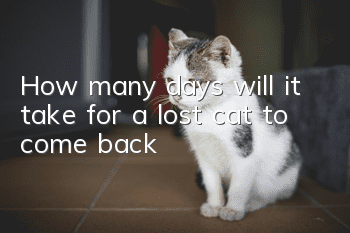Treatment of jaundice hepatitis in cats, treatment principles of feline hepatitis!

Cat jaundice
Treatment of feline jaundice hepatitis, treatment principles of feline hepatitis! Jaundice is a characteristic symptom. Feline jaundice is also called feline hyperbilirubinemia. The main symptoms are: Yellowing of skin, yellowing of eye conjunctiva, yellowing of oral mucosa, etc. Generally speaking, cats will show symptoms of jaundice when they develop liver disease. Hepatitis refers to a pathological state of the liver characterized by the infiltration of inflammatory cells and the like due to damage (degeneration, necrosis) of liver cells due to some reason. Morphologically, it can be divided into diffuse, focal and bile duct type.
The cause of cat jaundice is excessive bilirubin in the serum; bilirubin is released from the rupture of aging red blood cells, and indirect bilirubin is synthesized into direct bilirubin in the liver. Bilirubin is secreted into the intestine through the bile duct, part of the bilirubin re-enters the liver through the portal circulation, another part is excreted through the feces, and the remaining part is excreted into the urine through the systemic circulation through the kidneys. When liver metabolism and exocrine abnormalities occur, excess bilirubin can occur, which is called primary hepatic jaundice. Primary hepatic jaundice is the most common type of jaundice in cats. These primary liver diseases include: acute toxic hepatitis, cholangiohepatitis, cirrhosis, and feline fatty liver; other diseases that can cause liver damage include: diabetes, feline infections peritonitis, tumors and feline leukemia virus infection.
1. Causes of feline jaundice hepatitis
1. Toxicity: Chemicals such as carbon tetrachloride, arsenic and phosphorus, drugs such as aspirin and paracetamol, pesticides such as thallium TL, plants such as castor seeds and mushrooms, and eating food contaminated with aflatoxin can all induce poisoning. hepatitis. In addition, metabolic deficiencies and malnutrition (methionine, choline) may also induce hepatitis.
2. Infectiousness: Hepatitis is caused by infection with FIP virus, pseudotuberculosis, Taizeella, various pyogenic bacteria and fungi, etc.
3. Parasitic: caused by Toxoplasma gondii, flukes or roundworms invading the liver.
2. Symptoms
1. Symptoms include depression, loss of appetite, vomiting, diarrhea, and weight loss.
2. Symptoms include fever, anemia, jaundice and liver tenderness.
3. When liver cell damage is severe, symptoms of severe hepatic insufficiency may occur, including loss of appetite, vomiting, jaundice, abdominal pain, and bleeding tendencies. In addition, symptoms such as hypersensitivity or numbness, lethargy or lethargy, abnormal gait or inability to stand, and spasms may occur. symptom.
3. Treatment
1. Oral administration of American Denosyl, a specific drug for liver disease and hepatitis for cats, 2 times a day for the first 5 days, 1 capsule each time, and then change Take 1 tablet a day on an empty stomach. This medicine can help cats repair damaged liver cells, eliminate ascites, normalize bile function, reduce jaundice, and promote cats to eat actively. Generally, after 5 days, the cat will show significant improvement and can actively eat and recover mentally. After taking 1 box in a row, the cat willBasically recovered.
2. Feed high-quality, nutritionally balanced foods that are rich in energy and vitamins. As a source of protein, it is best to add skim low-energy butter, and as a carbohydrate, it can be fed to foods such as rice. Vitamins require B vitamins and vitamins A, D, E, and K. The energy required is 80~100kcal/kg/day. For animals without appetite, it is necessary to force feed them. In order to minimize vomiting and diarrhea, feed 5-10ml/kg of porridge 6-8 times a day. Sick cats showing neurological symptoms are best fed food containing 4g/kg/day protein, 6g/kg/day carbohydrate and 4.4g/kg/day fat. For sick cats who have undergone long-term food therapy, their weight should be measured regularly to check whether the daily feeding nutrition is appropriate.
Hills L/D cats are prescribed canned food, at least half a day. Owners can dilute the L/D canned food with water, fill it with a syringe, and eat small and frequent meals. When the cat regains its appetite and can eat dry food, it can be fed Hills L/D dry food. If the owner cannot buy L/D at the moment, he can use A/D instead.
3. Infusion: Take orally or inject sugary electrolyte solution (50-60ml/kg/day) according to the condition. At the same time, it is best to use B vitamins and vitamin K as supplements. Since the blood sugar level of this disease changes, the blood sugar should be measured before infusion and the amount of sugar supplement should be determined.
4. In order to promote choleretic effects, take dehydrocholic acid orally (3 times a day, 10 to 15 mg/kg each time). To reduce plasma ammonia, administer lactulose orally, arginine, or glutamine.
Notes:
1. Hospitalization, owners must not leave cats in the hospital. Feline hepatitis requires three points of treatment and seven points of care. The cases of successful treatment of feline hepatitis were all done under the careful care of the owners. If an owner leaves a cat with hepatitis in the hospital, the cat feels that she is dying, the owner abandons her, and her condition deteriorates rapidly, leading to death.
2. Use human albumin, Gan Tai Tablets and Liver Protecting Tablets to treat cats. Feline hepatitis is caused by damage to liver cells. Feline hepatitis medicine is used to repair liver cells. Human hepatitis is caused by viruses. , so human hepatitis drugs have no effect on feline hepatitis, and may even delay the condition.
3. Feline hepatitis is different from human hepatitis. Feline hepatitis is absolutely not contagious. The intravenous drip only maintains the cat's life and has no repair effect on feline hepatitis. There is no need for owners to take their cats for IV drips every day.
4. Colon lavage is absolutely not allowed. Colon lavage is no different from murdering a cat. Seriously ill people cannot tolerate colon lavage, let alone a weak and seriously ill cat.
It must be pointed out that feline jaundice does not necessarily indicate hepatitis. When we receive a case of jaundice, we need to diagnose the cause clearly. The examination items we need to do include routine blood tests (CBC ), blood smear, full set of biochemical tests, urine test, chest and abdominal X-rays, blood agglutination test, blood parasite test, serum bile acid test, transmissionInfectious disease detection, abdominal B-ultrasound examination, liver biopsy and even laparotomy, etc.
- What does it mean when a cat meows while looking at you?
- What exactly does hair removal cream do?
- Does a cat need to drink more hot water if it has a cold?
- What is the personality of the American Shorthair cat?
- Cat paw pad shape character
- Why does a cat have so much eye mucus?
- What should I do if my cat’s fur is tangled and stuck to the skin?
- What does it mean when a cat's ears are turned sideways?
- How many times a day should a three-month-old kitten be fed?
- How to treat cat moss around the cat's mouth?



